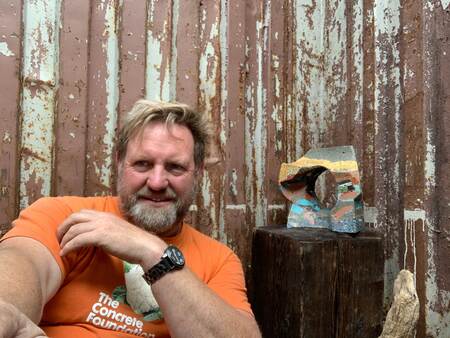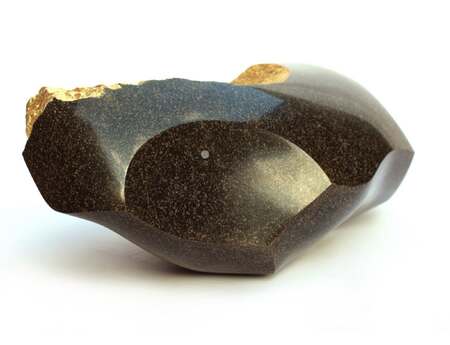
United Kingdom
Russell Coleman
Russ Coleman uses the skills and practices he learned as a Monumental Mason and letter carver combined with his experience in the construction industry to create works that celebrate the world around us. After ten years of craft and graft, Russ studied Fine art in Kingston upon Hull in the early 1990s and has created public artworks all over the United Kingdom for the past 25 years.
His latest works extend a long tradition of British sculpture combining humanity and landscape. Russ’s return to stone as an expressive medium has produced a set of works that are as rich as they are simple. They are a quite contemplation of geological time and the brevity of life.
Polishing stones and Yugen
Polishing produces a lens into the stone; it gives us an otherwise unseen glimpse into the rock’s history written in a physical language of minerals. By polishing the surface we can define individual grains and crystals, see the depth and range of tone and read the makeup of the stone.
There are infinite varieties of colour and pattern caused by random chance, but these can only be viewed by polishing the surface of the stone. These polished boulders are snapshots of an ongoing process. They bear witness to a violent and chaotic birth, the unleashing of immense energy and the crushing pressure of gravity and time. Many are igneous volcanic rocks with fine crystals that tell of rapid cooling. Others have large crystal formations from slow cooling at the centre of lava flows or pools. Differing minerals form a vast range of colour and contrast. The process and heaving and shifting produces cross banding and fracturing that become infilled with mineral veins. Some of the rocks I have carved and polished are thee and a half billion years old.
Others are sedimentary and can include signs of life such as fossils of shells, plants or corrals.
However long we choose to gaze at these polished stones, it is a still a brief glimpse of the object on its endless journey of atrophy or transformation on a timescale beyond humanity. When I select, polish and present a stone to an audience, I am only temporarily removing it from that journey. That we look at them for seconds or minutes and can comprehend this is what the Japanese call Yugen
Yūgen suggests that which is beyond what can be said, but it is not an allusion to another world.[11]It is about this world, this experience
His latest works extend a long tradition of British sculpture combining humanity and landscape. Russ’s return to stone as an expressive medium has produced a set of works that are as rich as they are simple. They are a quite contemplation of geological time and the brevity of life.
Polishing stones and Yugen
Polishing produces a lens into the stone; it gives us an otherwise unseen glimpse into the rock’s history written in a physical language of minerals. By polishing the surface we can define individual grains and crystals, see the depth and range of tone and read the makeup of the stone.
There are infinite varieties of colour and pattern caused by random chance, but these can only be viewed by polishing the surface of the stone. These polished boulders are snapshots of an ongoing process. They bear witness to a violent and chaotic birth, the unleashing of immense energy and the crushing pressure of gravity and time. Many are igneous volcanic rocks with fine crystals that tell of rapid cooling. Others have large crystal formations from slow cooling at the centre of lava flows or pools. Differing minerals form a vast range of colour and contrast. The process and heaving and shifting produces cross banding and fracturing that become infilled with mineral veins. Some of the rocks I have carved and polished are thee and a half billion years old.
Others are sedimentary and can include signs of life such as fossils of shells, plants or corrals.
However long we choose to gaze at these polished stones, it is a still a brief glimpse of the object on its endless journey of atrophy or transformation on a timescale beyond humanity. When I select, polish and present a stone to an audience, I am only temporarily removing it from that journey. That we look at them for seconds or minutes and can comprehend this is what the Japanese call Yugen
Yūgen suggests that which is beyond what can be said, but it is not an allusion to another world.[11]It is about this world, this experience
